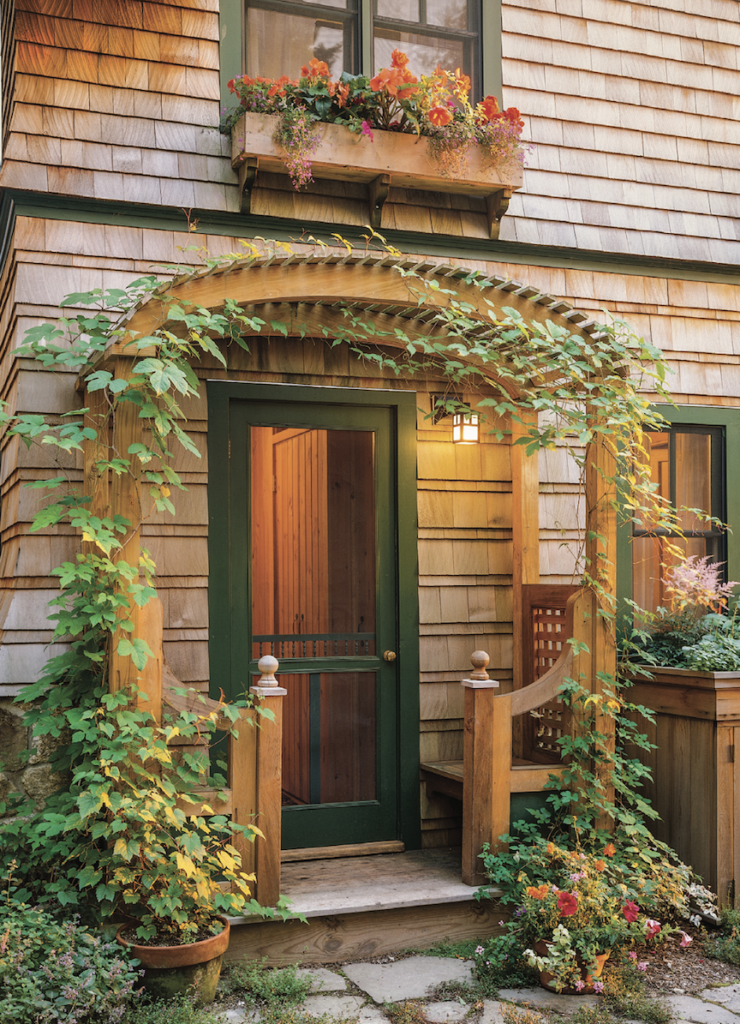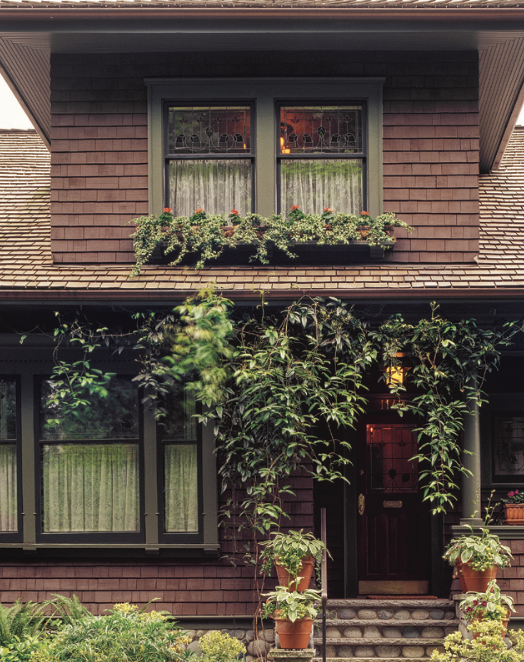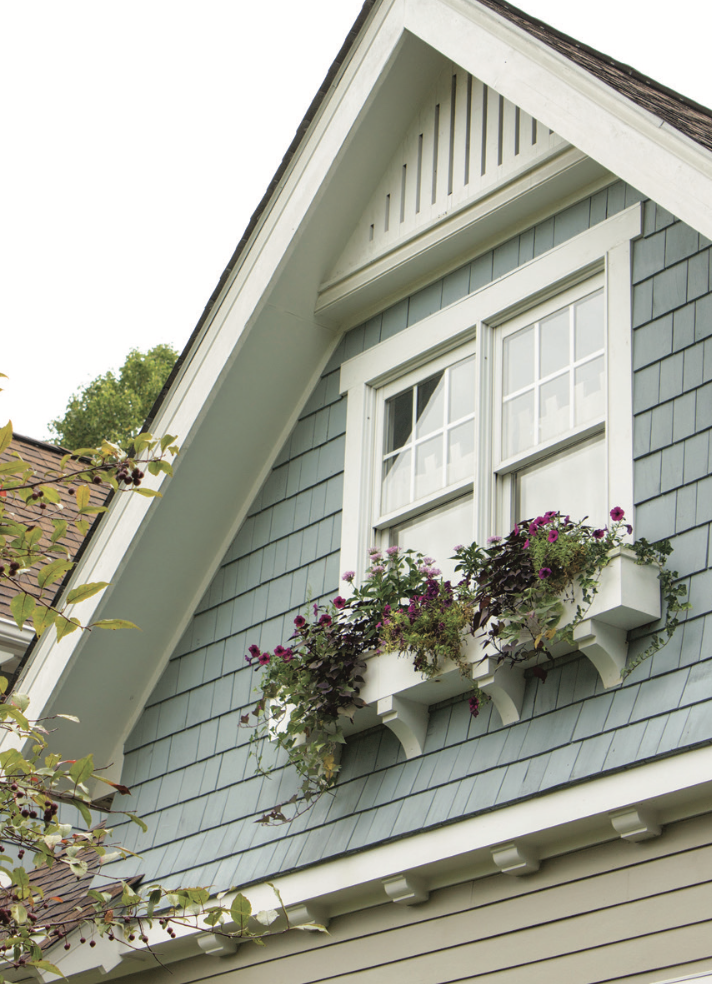HISTORICAL
Plants have always thrived at the window, but the heyday of the window box was during gardening’s golden age in the early 20th century. Their popularity matched the bungalow’s natural aesthetic; it also coincided with smaller lots, which encouraged container gardening. Boxes are ubiquitous on Historical Revival styles: Cotswold cottages, Dutch Colonials, and cozy, informal houses with sloping roofs and wood shutters. Some Spanish and Mediterranean houses built in the 1920s have wrought-iron window-box cages; a box slips inside. The iron is securely bolted to the house, and water easily drains away.
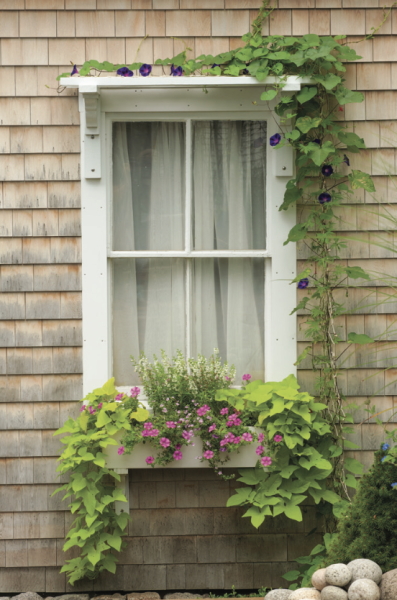
These windows have boxes below the sill, with pergola hoods above.
Brian Vanden Brink
DESIGN POINTS
Size and proportion are critical for large boxes on a primary façade. The box should extend several inches beyond corbels or brackets and windowsills (approximately the width of the window or group of windows), and rise approximately the height of short windows and 1/5 the height of tall windows. You might make a cardboard cutout of the proposed box, to check size and proportion. You can even paint the cardboard to check whether the box will look best in the house’s body, sash, trim, or accent color.
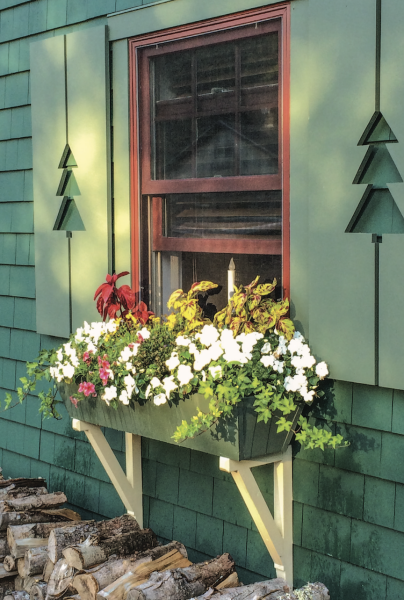
Oversized brackets are part of a charming window dressing that includes cutout cottage shutters.
Ken Druse
Where there are three windows, say, in a group, you may use three matching boxes close together, or one long one. As to height of the box, a rule of thumb is 20 to 25% of the height of the windows. If windows are very large and tall, adding brackets can help with proportion.
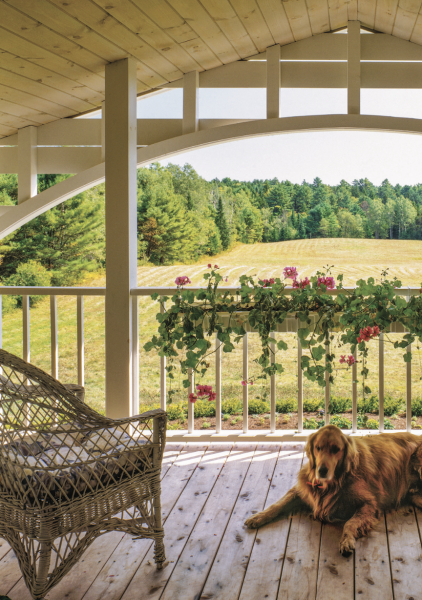
Simple hooks hold a long box below the rail, resting against spindles.
Brian Vanden Brink, Design by Orcutt Associates Architects
Long and large window boxes will be very heavy once filled with soil and plants. You can plant in the liner (either at the potting bench or with the liner already in place). Water after the box is hung. A railing box is hard to get just right; again, you might want to try out plastic liners or make a cardboard template. Too small and they look spotty (plus, small boxes dry out quickly). Too big and they may interfere with the safety and utility of the rail, particularly near stairs.
WINDOW BOX TYPES
In most cases, buy a simple box that requires little maintenance; not even halfway through the season, your plants will cover the box anyway. The exception is when the box is large and prominent and will remain on the house year-round. In that case, natural materials that age with patina (real wood, iron, copper, stone, cement) are better than plastics and even too-perfect PVC.
Historically, the window boxes were made of rot-resistant wood. Stone and concrete were used regionally. Chicago’s brick bungalows, as an example, had boxes of unpainted cast stone or concrete, often detailed with geometric bands or scrolls. Replacing them in kind can get pricey —$400 and up. Using a concrete box is appropriate, it will develop patina, and it’s too heavy to steal. But drainage may not be adequate, you have fewer options for size, plants will need more frequent watering, and the box may crack during freeze–thaw cycles.
Wood, commonly cedar, is the most popular material today and cheaper than stone or cement. Design and color options abound, wood is easier to move, plants stay cooler and better drained. But wood does require refinishing every few years.
Metal, fiberglass, and PVC planters are fairly economical. (Plastic must be kept painted to avoid fading and crack- ing.) PVC planter boxes look like painted wood; many come with a factory finish, and some manufacturers offer real bronze coating. Unlike vinyl, wood, and most metal boxes, a box made of cellular PVC will not rot, sag, crack, or rust.
Fiberglass boxes (made of a reinforced resin used for surfboards) are generally available from 24″ to 72″ long. Paint color may match window trim, or choose a neutral color that complements the masonry and doesn’t compete with the plants.
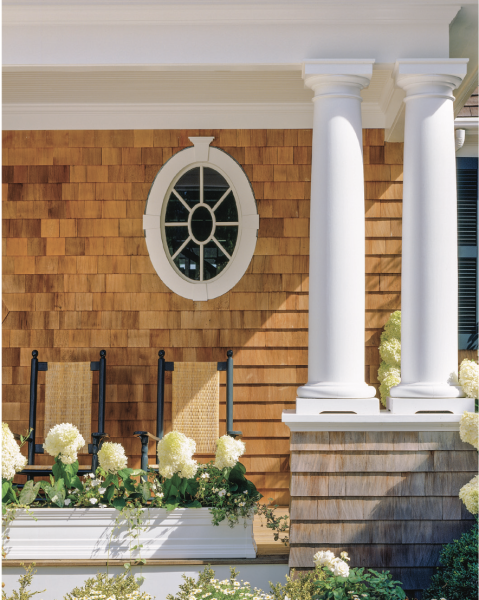
Large planter boxes may stand in for a balustrade on low porches.
Kindra Clineff
Metal grille enclosures are handsome, recalling somewhat those European balconettes or false balconies enclosing tall upper-storey windows or French doors.
If you have a special design situation— the box is an unusual size or proportion, or you want to match an original—you’ll want a custom box or to make it yourself. Rot-resistant cedar remains a good choice in much of the country. Adequate drainage holes are a necessity. Prime cedar boxes with an oil-based, stain-blocking primer. Let the primer dry for at least a day before you apply finish coats. Use compatible, high-quality exterior paint. The box will stay cleaner and be washable if you use a semi-gloss paint.
Liners are readily available and most are cheap; Home Depot has many types and sizes. The liner may be plastic or galvanized metal. For a wrought-iron box cage, use copper or galvanized metal (or a lined wood box), not plastic. Metal liners for this purpose come powder-coated in a range of colors, including a real copper finish that will develop patina.
The liner makes planting easier, holds moisture, and protects the wood box from wet soil and eventual deterioration.
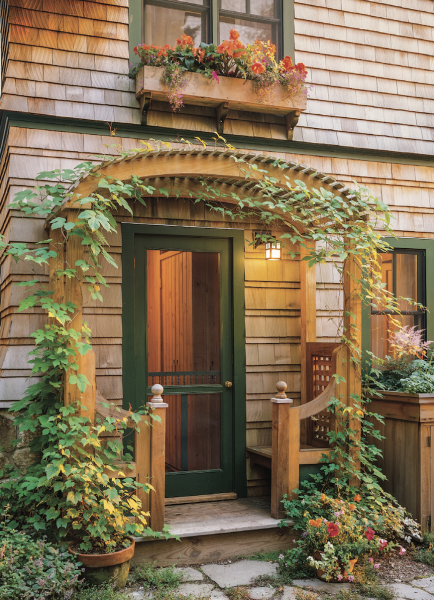
An upstairs box crowns a doorway arbor with built-in seats.
Brian Vanden Brink, Design by Priestly Associates Architecture
ATTACHMENT
Heavy boxes will stay put on masonry corbels or a sill. If there’s concern about the box shifting or falling, perhaps because of wind load or structural issues, do attach the back of the box itself to the masonry or to studs in the wall under the window. Boxes filled with wet soil are heavy: you don’t want it falling on the house, taking sheathing with it or hitting somebody. Check for level and drill pilot holes, then use lag bolts or a combination of clips and bolts. Cleats (interlocking brackets placed on the wall and the back of the window box) create an invisible hanging system.
Wooden brackets, screwed into wall studs, can be used for additional support and visual interest. Again, use best practices for attaching the brackets to wood or masonry. Even with brackets, bolt the back of the box to the wall if it is on an upper storey or likely to shift.
Note, however, that the box should not contact the wall. Always leave space for water to drain and for shingles or stucco to dry out. Ideally, the liner will keep the box itself relatively dry. Inspect the box for damage or rot at the end of the season.



